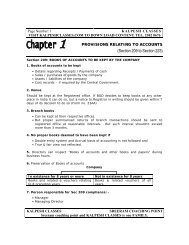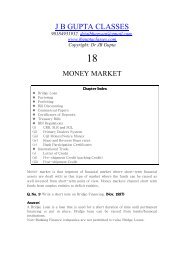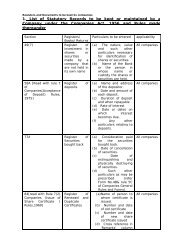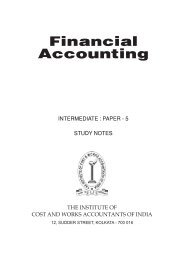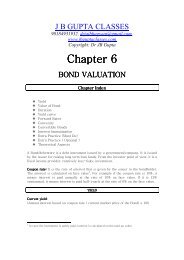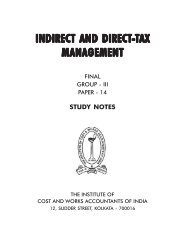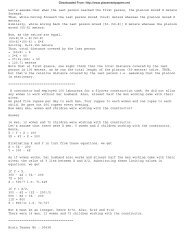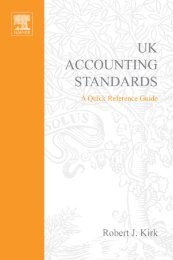- Page 2: VALUATION FORFINANCIALREPORTINGFair
- Page 6 and 7: VALUATION FORFINANCIALREPORTINGFair
- Page 8: To our familiesnear and faryoung an
- Page 12 and 13: PrefaceThe second edition of this b
- Page 14: AcknowledgmentsTo Deanna Muraki, th
- Page 17 and 18: xivAbout the Authorsappraiser with
- Page 20: Valuation for FinancialReportingFai
- Page 23: 2 Valuation for Financial Reporting
- Page 27 and 28: 6 Valuation for Financial Reporting
- Page 29 and 30: 8 Valuation for Financial Reporting
- Page 31 and 32: 10 Valuation for Financial Reportin
- Page 33 and 34: 12 Valuation for Financial Reportin
- Page 35 and 36: 14 Valuation for Financial Reportin
- Page 37 and 38: 16 Valuation for Financial Reportin
- Page 39 and 40: 18 Valuation for Financial Reportin
- Page 41 and 42: 20 Valuation for Financial Reportin
- Page 43 and 44: Appendix 1.2Pronouncements Excluded
- Page 45 and 46: 24 Valuation for Financial Reportin
- Page 47 and 48: 26 Valuation for Financial Reportin
- Page 49 and 50: 28 Valuation for Financial Reportin
- Page 51 and 52: 30 Valuation for Financial Reportin
- Page 53 and 54: 32 Valuation for Financial Reportin
- Page 55 and 56: 34 Valuation for Financial Reportin
- Page 57 and 58: 36 Valuation for Financial Reportin
- Page 59 and 60: 38 Valuation for Financial Reportin
- Page 61 and 62: 40 Valuation for Financial Reportin
- Page 63 and 64: 42 Valuation for Financial Reportin
- Page 65 and 66: 44 Valuation for Financial Reportin
- Page 67 and 68: 46 Valuation for Financial Reportin
- Page 69 and 70: 48 Valuation for Financial Reportin
- Page 71 and 72: Intellectual PropertyAppendix 2.1On
- Page 73 and 74: 52 Valuation for Financial Reportin
- Page 75 and 76:
54 Valuation for Financial Reportin
- Page 77 and 78:
Appendix 2.2Significant Changes in
- Page 79 and 80:
58 Valuation for Financial Reportin
- Page 81 and 82:
60 Valuation for Financial Reportin
- Page 83 and 84:
62 Valuation for Financial Reportin
- Page 85 and 86:
64 Valuation for Financial Reportin
- Page 87 and 88:
66 Valuation for Financial Reportin
- Page 89 and 90:
# Copyright 2007 by FVG Holdings, L
- Page 91 and 92:
Exhibit 3.4 Target Company Business
- Page 93 and 94:
Exhibit 3.5 Target Company Business
- Page 95 and 96:
74 Valuation for Financial Reportin
- Page 97 and 98:
76 Valuation for Financial Reportin
- Page 99 and 100:
78 Valuation for Financial Reportin
- Page 101 and 102:
Exhibit 3.7 Target Company Valuatio
- Page 103 and 104:
Exhibit 3.7 (Continued)No. Job Titl
- Page 105 and 106:
Exhibit 3.8 Target Company Valuatio
- Page 107 and 108:
86 Valuation for Financial Reportin
- Page 109 and 110:
88 Valuation for Financial Reportin
- Page 111 and 112:
90 Valuation for Financial Reportin
- Page 113 and 114:
Exhibit 3.10 Target Company Calcula
- Page 115 and 116:
94 Valuation for Financial Reportin
- Page 117 and 118:
96 Valuation for Financial Reportin
- Page 119 and 120:
98 Valuation for Financial Reportin
- Page 121 and 122:
100 Valuation for Financial Reporti
- Page 123 and 124:
102 Valuation for Financial Reporti
- Page 125 and 126:
104 Valuation for Financial Reporti
- Page 127 and 128:
Exhibit 3.16 (Continued)Total Fair
- Page 129 and 130:
Exhibit 3.17 (Continued)2017 Taxabl
- Page 131 and 132:
110 Valuation for Financial Reporti
- Page 133 and 134:
112 Valuation for Financial Reporti
- Page 135 and 136:
Exhibit 3.19 Target Company Valuati
- Page 137 and 138:
Exhibit 3.19 (Continued)No. Job Tit
- Page 139 and 140:
118 Valuation for Financial Reporti
- Page 141 and 142:
120 Valuation for Financial Reporti
- Page 143 and 144:
Exhibit 3.22 Target Company Calcula
- Page 145 and 146:
124 Valuation for Financial Reporti
- Page 147 and 148:
Exhibit 3.23 (Continued)(5) After-t
- Page 149 and 150:
Exhibit 3.24 (Continued)Sum of Retu
- Page 151 and 152:
130 Valuation for Financial Reporti
- Page 153 and 154:
Exhibit 3.27 Target Company Summary
- Page 155 and 156:
134 Valuation for Financial Reporti
- Page 157 and 158:
136 Valuation for Financial Reporti
- Page 159 and 160:
Exhibit 4.2 Report Standard Compara
- Page 161 and 162:
Exhibit 4.2 (Continued)StandardNACV
- Page 163 and 164:
142 Valuation for Financial Reporti
- Page 165 and 166:
144 Valuation for Financial Reporti
- Page 167 and 168:
146 Valuation for Financial Reporti
- Page 169 and 170:
148 Valuation for Financial Reporti
- Page 171 and 172:
150 Valuation for Financial Reporti
- Page 173 and 174:
152 Valuation for Financial Reporti
- Page 175 and 176:
154 Valuation for Financial Reporti
- Page 177 and 178:
156 Valuation for Financial Reporti
- Page 179 and 180:
158 Valuation for Financial Reporti
- Page 181 and 182:
160 Valuation for Financial Reporti
- Page 183 and 184:
162 Valuation for Financial Reporti
- Page 185 and 186:
Exhibit 4.3 Target Company Business
- Page 187 and 188:
Exhibit 4.4 (Continued)Actual Forec
- Page 189 and 190:
168 Valuation for Financial Reporti
- Page 191 and 192:
Exhibit 4.8 Target Company Valuatio
- Page 193 and 194:
Exhibit 4.9 Target Company Valuatio
- Page 195 and 196:
174 Valuation for Financial Reporti
- Page 197 and 198:
176 Valuation for Financial Reporti
- Page 199 and 200:
178 Valuation for Financial Reporti
- Page 201 and 202:
180 Valuation for Financial Reporti
- Page 203 and 204:
182 Valuation for Financial Reporti
- Page 205 and 206:
184 Valuation for Financial Reporti
- Page 207 and 208:
186 Valuation for Financial Reporti
- Page 209 and 210:
188 Valuation for Financial Reporti
- Page 211 and 212:
190 Valuation for Financial Reporti
- Page 213 and 214:
192 Valuation for Financial Reporti
- Page 215 and 216:
194 Valuation for Financial Reporti
- Page 217 and 218:
196 Valuation for Financial Reporti
- Page 219 and 220:
198 Valuation for Financial Reporti
- Page 221 and 222:
200 Valuation for Financial Reporti
- Page 223 and 224:
202 Valuation for Financial Reporti
- Page 225 and 226:
204 Valuation for Financial Reporti
- Page 227:
206 Valuation for Financial Reporti
- Page 231 and 232:
210 IndexBusiness Enterprise Analys
- Page 233 and 234:
212 IndexGoodwill (continued )111,
- Page 235 and 236:
214 IndexLong-termcapital, 71debt,
- Page 237 and 238:
216 IndexSecurities and Exchange Co



